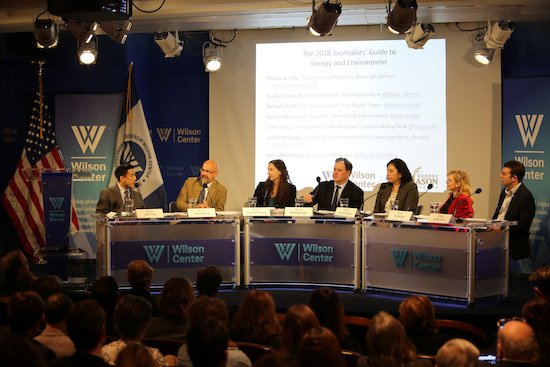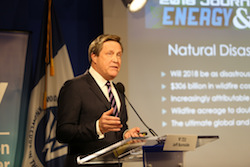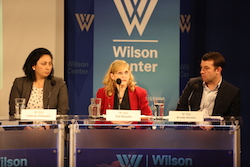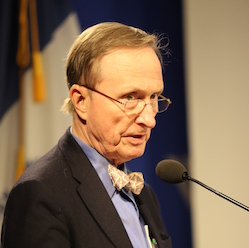SEJournal Online is the digital news magazine of the Society of Environmental Journalists. Learn more about SEJournal Online, including submission, subscription and advertising information.
 |
| Panelists at an SEJ-Wilson Center event warned of showdowns in the year ahead over environment and energy policy. Left to right, moderator Scott Tong of Marketplace, Nirmal Ghosh of the Straits Times, Ariel Wittenberg of E&E News, Matthew Daly of the AP, Valerie Volcovici of Reuters, Pat Rizzuto of Bloomberg Environment and Brady Dennis of the Washington Post. Photo: Courtesy Wilson Center |
SEJ News: Policy ‘Confrontation’ is Watchword, Say Journalists at Issue Look-Ahead Forum
By Joseph A. Davis
This story is one in a series of special reports from SEJournal’s Joseph A. Davis that looks ahead to key issues in the coming year. Visit the full “2018 Journalists’ Guide to Energy & Environment” special report for more.
 |
Expect confrontation — that was the guidance to environment and energy journalists from an all-star panel in Washington, D.C. on Jan. 26 about what big stories will be coming in 2018.
There will be showdowns over the climate plan of the U.S. Environmental Protection Agency, over drilling on public lands, over environmental laws themselves, over infrastructure, national monuments and more, panelists added.
The program was part of an event co-sponsored by the Society of Environmental Journalists, the Wilson Center and George Mason University. An overflow crowd jammed the Wilson Center auditorium in Washington, D.C., while thousands more watched online.
Former SEJ President Jeff Burnside presented keynote remarks for the 2018 “Journalists’ Guide to Energy and Environment.” A complement of panelists and experts then added their own outlook on how the coming year would shape up for media. Substantial discussion and audience Q&A fleshed out the finer points during the two-hour event.
‘Delivering truth extra hard’
Burnside’s take included a distillation of the detailed guide published by the SEJournal Online, breaking down coming stories by issue area.
For example, he said that 2018 will show whether President Donald Trump’s plans for dramatically reversing former President Barack Obama’s environmental policies will gain more traction as federal agencies try to carry them out. Much of the contest will be played out in the courts.
Burnside added that “delivering the truth will be extra hard this year” because there will be so much science involved. General assignment reporters will have to keep asking: “How do you know that?” Questions of what scientists the EPA listens to, who pays them and the integrity of the science itself will come to the forefront.
 |
| Former SEJ President Jeff Burnside presented one of the keynote addresses at the afternoon-long event. Photo: Courtesy Wilson Center |
How — and whether — environmental agencies can govern will continue to make news, SEJ’s guide predicted. Trump administration appointments to top echelons of federal agencies are still going on and engendering controversy. Reorganization and downsizing at key agencies like EPA and Interior may be drastic.
And the 2018 midterm elections themselves will drive policy even before voters make their decision — and may change policy even more if Democrats can regain control of House or Senate.
Another keynote speaker, Ed Maibach of George Mason University’s Center for Climate Change Communication, told the audience about a pace-setting project on climate change reporting in partnership with SEJ. The focus of the project is how local broadcast weather forecasters talk about climate change.
According to Maibach, most local TV audiences see climate as distant in time and space — something that happens in the far future only to polar bears in the Arctic. Trusted TV weathercasters can change that, he argued.
Few weathercasters talked about climate at the start of the project, Maibach said. Now, after education via the “Climate Matters” program, that has changed. Many more are doing climate stories today.
A year for ‘legal nerds’
The heart of the SEJ-Wilson Center event was a top-level panel of environment/energy journalists moderated By Scott Tong, an experienced investigative reporter from the sustainability desk at American Public Media’s Marketplace.
Panelist Brady Dennis, an environmental reporter for the Washington Post, was asked how EPA could do so many things in so short a time. “The glib answer to that is Scott Pruitt’s stamina and ambition,” commented Dennis. “Neither are small.”
He stressed that the executive branch has lots of power to do things even without action by Congress, as Obama himself proved during his own administration. He pointed reporters at the many smaller executive actions, often missed by reporters, that can shape an agency. EPA employee buyouts were one example he offered — along with the myriad obscure regulatory and court struggles.
“If you are a legal nerd,” quipped Dennis, “This is going to be your year.”
 |
| Dennis (right) called it a year for "legal nerds, while Rizzuto (center) predicted activity on TSCA and Volcovici (left) said the coal revival story is "not necessarily a great one." Photo: Courtesy Wilson Center |
A number of the panelists told Tong that in the coming year it would be more important than ever to have sources inside the agencies.
Panelist Pat Rizzuto, who covers chemicals for Bloomberg Environment, said that 2018 would see lots of activity related to implementation of the 2016 revision of the Toxic Substances Control Act. The TSCA reform promised to fix the obsolete and ineffective law to truly evaluate the toxicity of chemicals in commerce — gathering enough data from companies and giving the public necessary data.
While companies and health advocates had largely united to get the law passed, Rizzuto said that as implementation has progressed, they were “back in their corners with their boxing gloves on,” ready to fight out issues in the courts.
She said one sign that implementation was working in the coming year would be if fewer states were relying on their own single-state regulatory schemes.
Zinke stirs up hornet’s nest on offshore drilling
Another panelist, Valerie Volcovici, a D.C.-based energy and environment reporter for Reuters, was asked whether Trump was indeed delivering on his campaign promise to bring back the coal industry. She noted that while he had done a lot to deregulate the coal industry, last year saw an increase of just 771 coal jobs, mostly in West Virginia and Pennsylvania, which were offset by decreasing coal jobs elsewhere, especially in the West.
“The story is not necessarily a great one,” Volcovici said. She said any rebound “is never going to be huge,” and that the real question was what will be done to diversify economies in coal states.
Matthew Daly, a mainstay environment and energy reporter for the Associated Press, said Interior Secretary Ryan Zinke’s key motivation was that he “very much wants to be Trump’s favorite guy, he wants to be the guy that Trump looks to, who is pushing his agenda.”
 |
| Scientist and biodiversity expert Thomas Lovejoy warned that “toxic substances constitute one of the biggest environmental threats down the line.” Photo: Courtesy Wilson Center |
But Daly said Zinke may not have done well for his boss in the way he rolled out Trump’s drill-every-coast offshore drilling plan. By giving the impression that he had carved out a political exemption for Florida after a short airport conversation, he stirred up a hornet’s nest of other states wanting exemptions. Those demands may go on and on this year.
Ariel Wittenberg, a reporter for E&E News, talked about the consequences of the Supreme Court’s Jan. 22 decision on the “WOTUS rule” that tried to define which waters of the U.S. were subject to the Clean Water Act. By throwing jurisdiction over the issue back to the many federal district courts, the high court probably ordered up at least another year’s worth of litigation for environmental reporters to watch in 2018.
But that situation will be complicated by the Trump EPA’s declared determination to repeal the Obama WOTUS rule and replace it with a new one of its own — covering fewer waters and wetlands. Writing a new rule will involve more debate — and more news.
Wittenberg also said the Trump EPA’s attempt to rewrite the rule on lead in drinking water would be another significant story.
Lovejoy: ‘Thank goodness for the environmental journalists’
Panelist Nirmal Ghosh, U.S. bureau chief for the Straits Times, has extensive experience with wildlife issues in places like the Philippines, India and Thailand. He said conflicts between humans and wildlife were likely to increase in Asia and other places, and that these conflicts would ripple through the global economy. Energy development will be one example, Ghosh said, but exploitation of forest lands for palm oil would be another.
One good news story, he suggested, was that different species of wildlife were learning to live successfully in or near human habitats in many places. Coyotes in the United States are one example close to home.
Ghosh also said that it was disconcerting to see the devaluation of science in the climate discussion in the United States. Climate change, he said, is a huge force on wildlife habitats.
The afternoon-long program was graced with an appearance by Thomas Lovejoy, a scientist who played a seminal role in public understanding of biodiversity — and the threats to it. He concluded the proceedings, remarking that “toxic substances constitute one of the biggest environmental threats down the line,” pointing to the recently observed decline of insect populations.
“Welcome to the land of the swamp … and we know that swamps are great things,” ” Lovejoy told the crowd, adding, “Thank goodness for the environmental journalists.”
Other event sponsors included The Nature Conservancy, the National Park Foundation, the Wilderness Society, Environment America and the Environmental Law Institute. Wilson Center’s Meaghan Parker, an SEJ board member, organized the conference.
Editor's Note: A webcast of the event is archived here.
* From the weekly news magazine SEJournal Online, Vol. 3, No. 5. Content from each new issue of SEJournal Online is available to the public via the SEJournal Online main page. Subscribe to the e-newsletter here. And see past issues of the SEJournal archived here.













 Advertisement
Advertisement 



